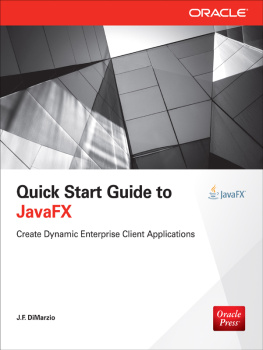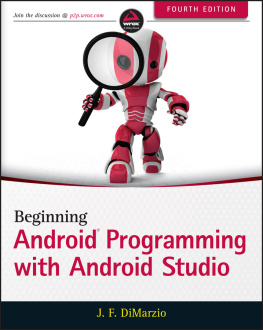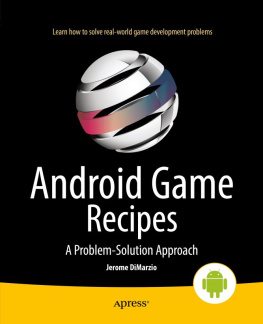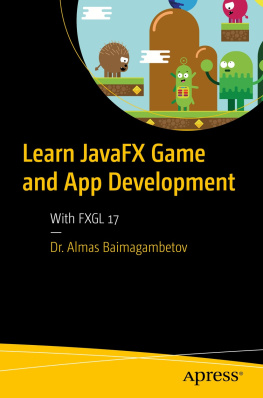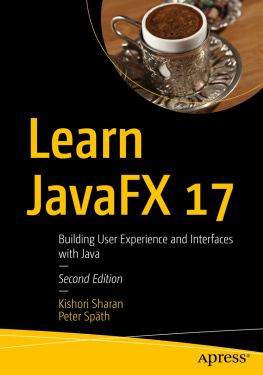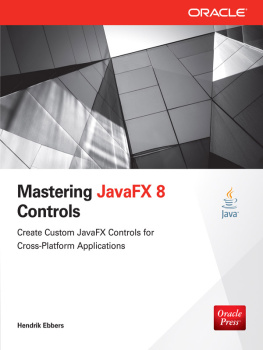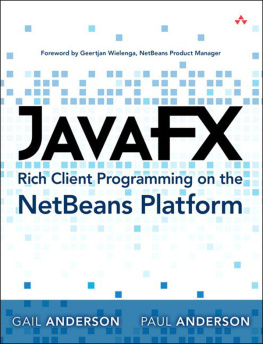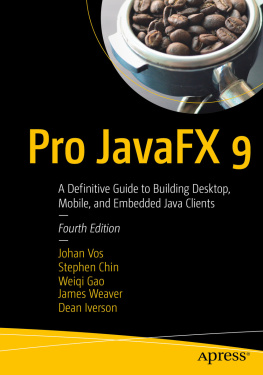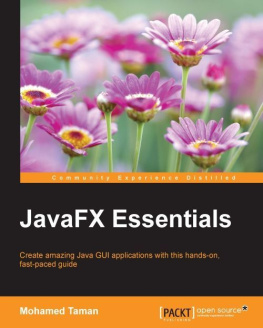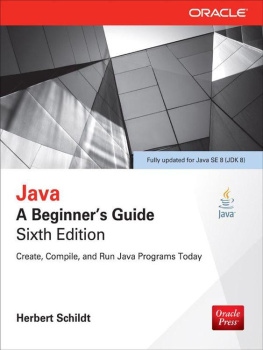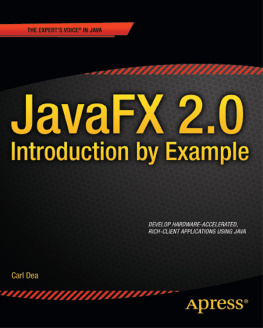Quick Start Guide to JavaFX
About the Author
J.F. DiMarzio is a seasoned developer. He began developing in BASIC on the TRS-80 Color Computer II in 1984. Since then, DiMarzio has worked in the technology departments of companies such as the U.S. Department of Defense and the Walt Disney Company. He continues to strive to push the limits of technology and develop on new, emerging platforms.
DiMarzio is also an accomplished author. Over the last 12 years, he has released 11 books, including the first edition of JavaFX: A Beginners Guide. His books have been translated into four different languages and published worldwide. DiMarzios writing style is very easy to read and understand, which makes the information in the topics he presents more retainable.
About the Technical Editor
Simon Ritter is the manager of the Java Technology Evangelist team at Oracle Corporation. Simon has been in the IT business since 1984 and holds a Bachelor of Science degree in Physics from Brunel University in the U.K.
Originally working in the area of UNIX development for AT&T UNIX System Labs and then Novell, Simon moved to Sun in 1996. At this time he started working with Java technology and has spent time working both in Java development and consultancy. Having moved to Oracle as part of the Sun acquisition, he now focuses on the core Java platform, Java for client applications, and embedded Java. He also continues to develop demonstrations that push the boundaries of Java for applications, such as gestural interfaces, embedded robot controllers, and in-car systems. Follow Simon on Twitter, @speakjava, and visit his blog at blogs.oracle.com/speakjava.
Quick Start Guide to JavaFX
J. F. DiMarzio
New York Chicago San Francisco
Athens London Madrid Mexico City
Milan New Delhi Singapore Sydney Toronto
Copyright 2014 by McGraw-Hill Education (Publisher). All rights reserved. Printed in the United States of America. Except as permitted under the Copyright Act of 1976, no part of this publication may be reproduced or distributed in any form or by any means, or stored in a database or retrieval system, without the prior written permission of publisher, with the exception that the program listings may be entered, stored, and executed in a computer system, but they may not be reproduced for publication.
ISBN: 978-0-07-180897-2
MHID: 0-07-180897-3
e-book conversion by Cenveo Publisher Services
Version 1.0
The material in this e-book also appears in the print version of this title: ISBN: 978-0-07-180896-5, MHID: 0-07-180896-5
McGraw-Hill Education e-books are available at special quantity discounts to use as premiums and sales promotions, or for use in corporate training programs. To contact a representative, please visit the Contact Us pages at www.mhprofessional.com.
Oracle is a registered trademark of Oracle Corporation and/or its affiliates. All other trademarks are the property of their respective owners, and McGraw-Hill Education makes no claim of ownership by the mention of products that contain these marks.
Screen displays of copyrighted Oracle software programs have been reproduced herein with the permission of Oracle Corporation and/or its affiliates.
Information has been obtained by McGraw-Hill Education from sources believed to be reliable. However, because of the possibility of human or mechanical error by our sources, McGraw-Hill Education, or others, McGraw-Hill Education does not guarantee the accuracy, adequacy, or completeness of any information and is not responsible for any errors or omissions or the results obtained from the use of such information.
Oracle Corporation does not make any representations or warranties as to the accuracy, adequacy, or completeness of any information contained in this Work, and is not responsible for any errors or omissions.
TERMS OF USE
This is a copyrighted work and McGraw-Hill Education (McGraw-Hill) and its licensors reserve all rights in and to the work. Use of this work is subject to these terms. Except as permitted under the Copyright Act of 1976 and the right to store and retrieve one copy of the work, you may not decompile, disassemble, reverse engineer, reproduce, modify, create derivative works based upon, transmit, distribute, disseminate, sell, publish or sublicense the work or any part of it without McGraw-Hills prior consent. You may use the work for your own noncommercial and personal use; any other use of the work is strictly prohibited. Your right to use the work may be terminated if you fail to comply with these terms.
THE WORK IS PROVIDED AS IS. McGRAW-HILL AND ITS LICENSORS MAKE NO GUARANTEES OR WARRANTIES AS TO THE ACCURACY, ADEQUACY OR COMPLETENESS OF OR RESULTS TO BE OBTAINED FROM USING THE WORK, INCLUDING ANY INFORMATION THAT CAN BE ACCESSED THROUGH THE WORK VIA HYPERLINK OR OTHERWISE, AND EXPRESSLY DISCLAIM ANY WARRANTY, EXPRESS OR IMPLIED, INCLUDING BUT NOT LIMITED TO IMPLIED WARRANTIES OF MERCHANTABILITY OR FITNESS FOR A PARTICULAR PURPOSE. McGraw-Hill and its licensors do not warrant or guarantee that the functions contained in the work will meet your requirements or that its operation will be uninterrupted or error free. Neither McGraw-Hill nor its licensors shall be liable to you or anyone else for any inaccuracy, error or omission, regardless of cause, in the work or for any damages resulting therefrom. McGraw-Hill has no responsibility for the content of any information accessed through the work. Under no circumstances shall McGraw-Hill and/or its licensors be liable for any indirect, incidental, special, punitive, consequential or similar damages that result from the use of or inability to use the work, even if any of them has been advised of the possibility of such damages. This limitation of liability shall apply to any claim or cause whatsoever whether such claim or cause arises in contract, tort or otherwise.
Neil, a great ally and agent over the last ten years.
Why This Book?
Welcome to Quick Start Guide to JavaFX. This book has been designed to give you the best first step into the exciting new frontier of JavaFX 8 development. JavaFX is a rich environment tool, and learning JavaFX is a must for anyone who wants to create immersive, interactive environments for users of any background.
If you are familiar with previous versions of JavaFX, this book is a must have. The platform has undergone major changes with the release of Java 8. Quick Start Guide to JavaFX covers the changes to JavaFX and prepares you for real-world development situations on this incredible platform.
This book takes you through JavaFX 8 in a logical manner. It begins by explaining the technology behind JavaFX. You will quickly move into installing the JavaFX development environment and tools. Although multiple development environments are available for JavaFX, the focus of this book is on teaching you the basics of NetBeans. NetBeans offers a rich, full-featured product that is easy to learn and will get you up and running in JavaFX in no time. By the end of the book, you are lead expertly into more complex examples to test your growing knowledge of developing rich JavaFX applications.

